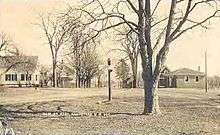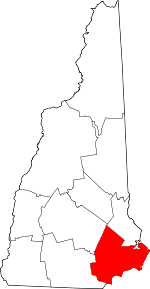Hampstead, New Hampshire
Hampstead is a town in Rockingham County, New Hampshire, United States. The population was 8,523 at the 2010 census.[1] Hampstead, which includes the village of East Hampstead, is home to a portion of the Rockingham Recreational Trail.
Hampstead, New Hampshire | |
|---|---|
 Seal | |
 Location in Rockingham County and the state of New Hampshire. | |
| Coordinates: 42°52′28″N 71°10′52″W | |
| Country | United States |
| State | New Hampshire |
| County | Rockingham |
| Incorporated | 1749 |
| Villages | Hampstead East Hampstead West Hampstead |
| Government | |
| • Board of Selectmen | Chad Bennett, Chair Joe Guthrie Sean Murphy |
| Area | |
| • Total | 14.0 sq mi (36.3 km2) |
| • Land | 13.3 sq mi (34.5 km2) |
| • Water | 0.7 sq mi (1.8 km2) 4.93% |
| Elevation | 315 ft (96 m) |
| Population (2010) | |
| • Total | 8,523 |
| • Estimate (2017) | 8,621 |
| • Density | 647/sq mi (249.9/km2) |
| Time zone | UTC-5 (Eastern) |
| • Summer (DST) | UTC-4 (Eastern) |
| ZIP codes | |
| Area code(s) | 603 |
| FIPS code | 33-32900 |
| GNIS feature ID | 0873615 |
| Website | www |
History

Once part of Haverhill and Amesbury, Massachusetts settled in 1640, this town was formed as a result of the 1739 decision fixing the boundary line between Massachusetts and New Hampshire. It was originally known as "Timberlane Parish" because of the heavy growth of native trees. The town would be incorporated in 1749 by Colonial Governor Benning Wentworth, who renamed it after Hampstead, England,[2] the residence of William Pitt, a close friend.
Hampstead was the home of the first honey factory in the United States, in 1816.
Geography
According to the United States Census Bureau, the town has a total area of 14.0 square miles (36 km2), of which 13.3 sq mi (34 km2) is land and 0.7 sq mi (1.8 km2) is water, comprising 4.93% of the town. Island Pond is in the west, with Angle and Wash ponds in the north. The highest point in Hampstead is greater than 460 feet (140 m) above sea level at the town's northwestern corner, near the eastern knob of Butman Hill. Hampstead lies mostly within the Merrimack River watershed, though the northern slope of Butman Hill drains into the Piscataqua River (Coastal) watershed.[3] Hampstead is home to Camp Tel Noar, an overnight summer camp on Wash Pond (Sunset Lake).
Adjacent municipalities
- Sandown, New Hampshire (north)
- Danville, New Hampshire (northeast)
- Kingston, New Hampshire (east)
- Plaistow, New Hampshire (southeast)
- Atkinson, New Hampshire (south)
- Derry, New Hampshire (west)
Demographics
| Historical population | |||
|---|---|---|---|
| Census | Pop. | %± | |
| 1790 | 724 | — | |
| 1800 | 790 | 9.1% | |
| 1810 | 738 | −6.6% | |
| 1820 | 751 | 1.8% | |
| 1830 | 913 | 21.6% | |
| 1840 | 890 | −2.5% | |
| 1850 | 789 | −11.3% | |
| 1860 | 930 | 17.9% | |
| 1870 | 935 | 0.5% | |
| 1880 | 950 | 1.6% | |
| 1890 | 860 | −9.5% | |
| 1900 | 823 | −4.3% | |
| 1910 | 796 | −3.3% | |
| 1920 | 670 | −15.8% | |
| 1930 | 775 | 15.7% | |
| 1940 | 823 | 6.2% | |
| 1950 | 902 | 9.6% | |
| 1960 | 1,261 | 39.8% | |
| 1970 | 2,401 | 90.4% | |
| 1980 | 3,785 | 57.6% | |
| 1990 | 6,732 | 77.9% | |
| 2000 | 8,297 | 23.2% | |
| 2010 | 8,523 | 2.7% | |
| Est. 2017 | 8,621 | [4] | 1.1% |
| U.S. Decennial Census[5] | |||
At the 2000 census there were 8,297 people, 3,044 households, and 2,279 families living in the town. The population density was 623.0 people per square mile (240.5/km²). There were 3,276 housing units at an average density of 246.0 per square mile (95.0/km²). The racial makeup of the town was 98.47% White, 0.23% African American, 0.08% Native American, 0.54% Asian, 0.05% Pacific Islander, 0.16% from other races, and 0.47% from two or more races. Hispanic or Latino of any race were 0.78%.[6]
Of the 3,044 households 41.1% had children under the age of 18 living with them, 66.2% were married couples living together, 6.0% had a female householder with no husband present, and 25.1% were non-families. 20.7% of households were one person and 6.1% were one person aged 65 or older. The average household size was 2.72 and the average family size was 3.19.
The age distribution was 28.9% under the age of 18, 5.1% from 18 to 24, 31.0% from 25 to 44, 25.6% from 45 to 64, and 9.3% 65 or older. The median age was 38 years. For every 100 females, there were 98.4 males. For every 100 females age 18 and over, there were 95.7 males.
The median household income was $68,533 and the median family income was $79,114. Males had a median income of $56,625 versus $31,449 for females. The per capita income for the town was $29,195. About 2.4% of families and 3.8% of the population were below the poverty line, including 6.3% of those under age 18 and 3.7% of those age 65 or over.
Education
Private schools
- Hampstead Academy
- Pinkerton Academy in Derry (Town of Hampstead pays tuition for town students to attend)
Public schools
Notable residents
- Andy Seuss (b. 1987), NASCAR driver
References
- United States Census Bureau, U.S. Census website, 2010 Census figures. Retrieved March 23, 2011.
- Gannett, Henry (1905). The Origin of Certain Place Names in the United States. Govt. Print. Off. pp. 148.
- Foster, Debra H.; Batorfalvy, Tatianna N.; Medalie, Laura (1995). Water Use in New Hampshire: An Activities Guide for Teachers. U.S. Department of the Interior and U.S. Geological Survey.
- "Annual Estimates of the Resident Population: April 1, 2010 to July 1, 2017 (PEPANNRES): Minor Civil Divisions – New Hampshire". Archived from the original on February 13, 2020. Retrieved November 15, 2018.
- "Census of Population and Housing". Census.gov. Retrieved June 4, 2016.
- "U.S. Census website". United States Census Bureau. Retrieved 2008-01-31.
External links
- Town of Hampstead official website
- Hampstead Historical Society
- Hampstead Public Library
- Tri-Town Times, community news
- New Hampshire Economic and Labor Market Information Bureau Profile
- Hampstead (N.H.: Town) Records at Dartmouth College Library
